SlashGear 101: Mac Pro 2013
Apple doesn't normally preview upcoming hardware, so when Tim Cook & Co. whipped out the new Mac Pro 2013 at WWDC 2013 this week you knew the company was particularly proud. Throwing away the old-style tower and completely rethinking not only the design, but the internal architecture, cooling, expansion, and ethos of a workstation, the Mac Pro 2013 will demand a new approach to computing from users, too, when it hits stores later this year. Read on as we break down what makes this Mac particularly special.
Design
Apple's old Mac Pro has looked largely the same since 2006, a silver tower clad in perforated aluminum. The new Mac pro keeps the aluminum – now in a polished black finish – but otherwise changes everything, now a cylinder 9.9-inches tall and 6.6-inches in diameter. "It's a pro desktop computer that can actually sit on your desk," Apple says.
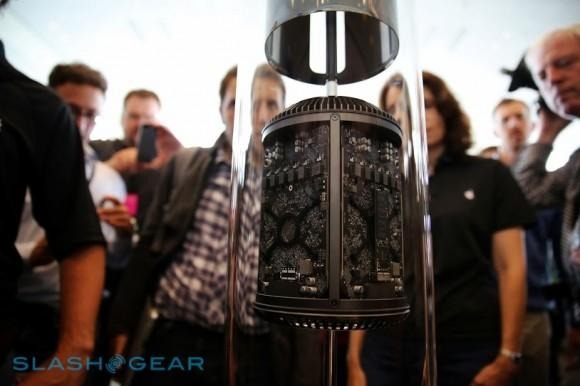
Rather than fitting the internal components flat, or stacking them, the Mac Pro 2013 arranges them facing outward around the central cooling core – more on which in the next section – and then allows the whole casing to lift up and off to expose all sides. A latch by the back panel makes for easy removal.
Although it may be round, just like a DVD or Blu-ray, there's no native optical drive. Whereas the Mac Pro has always been popular with music and video editing professionals, they'll now need to add an external burner if they want to produce or read physical media.
Cooling
The new Mac Pro may look set to be Apple's fastest Mac to-date, but it makes do with a single fan. It's no off-the-shelf unit, however: instead, the oversized fan looks more like an impeller you'd find on an aircraft, positioned horizontally on top of the cylindrical tower.
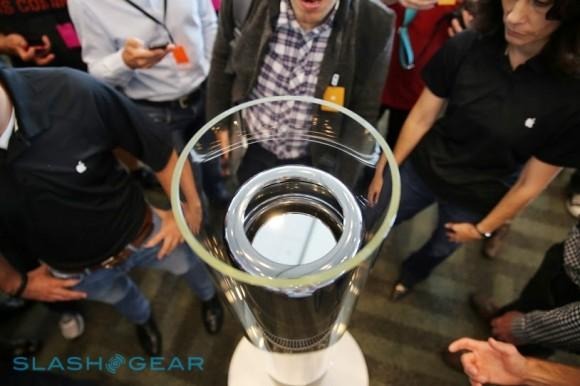
Those impeller blades are curved in such a way as to minimize noise while maximizing air throughput, Apple claims, making for an altogether more efficient flow. Air is sucked from vents cut at the bottom of the workstation, up through the middle, and out of the recessed outlets at the top, where the body of the Mac Pro meets the outer shell.
On the way through it passes across what Apple calls the "unified thermal core", a completely new layout for cooling. The mainboard and the two graphics cards are placed against the three sides of a triangular extruded aluminum heat-sink that monopolizes the middle of the Mac Pro, and which pulls heat away from the chips. Air pulled across the core from bottom to top draws away that heat, keeping the system cool.
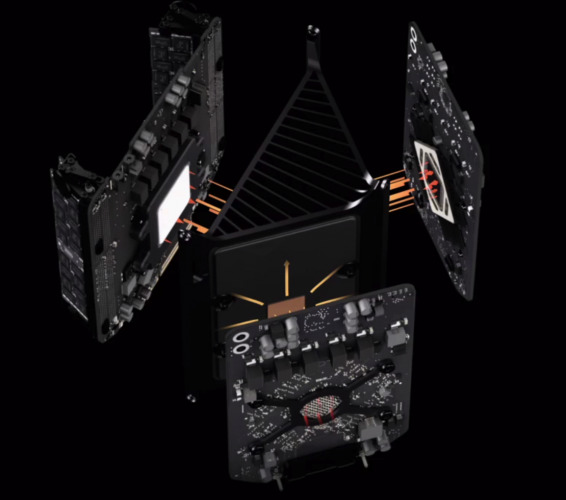
Heat sinks aren't new, of course, but by making the unified thermal core the centerpiece of the Mac Pro 2013, Apple has cut down on bulk overall. It's a big component, yes, but because it's shared by all three boards, it's supposedly a more efficient use of space than if the mainboard and two graphics cards each had its own heatsink. Meanwhile, if the processor is under load but the graphics aren't, the spare capacity of the core can be monopolized by the hottest component, or vice-versa, without having to dynamically adjust the rates of different fans in different parts of the system.
Processor and Memory
Apple has been waiting on Intel's new Xeon processors for some time now, and the updated chips have taken so long to arrive that there was speculation the new Mac Pro might shift to more-frequently-updated consumer CPUs. That hasn't happened, however, and instead the Mac Pro 2013 gets silicon from Intel's new Xeon E5 family.
Benchmarking will have to wait until production units are ready, but the headline claims are already impressive. Apple says floating-point performance on the new Mac Pro is up to twice as fast as the existing model, with up to twelve CPU cores on offer and 256-bit-wide floating point instructions. A 40GB/s PCI Express gen-3 connection keeps different aspects of the system communicating at their fastest.
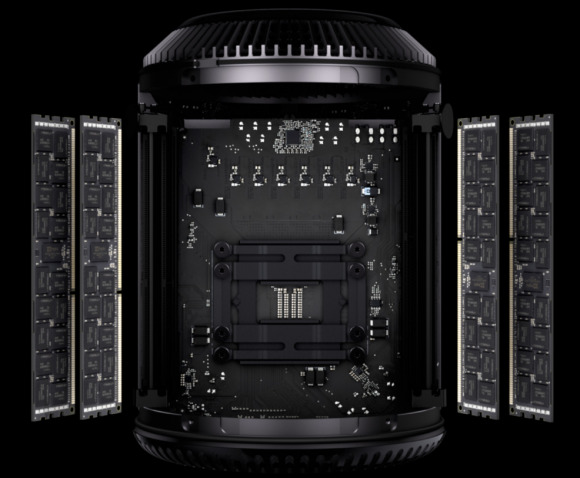
Flanking the mainboard, and opening out like a ribcage, are four DDR3 memory slots. Just as with floating-point performance, memory bandwidth is said to have doubled to 60GB/s, with the controller running at 1866MHz. Memory is also one of the easiest (and, indeed, few) components that can be readily changed by the user, with the standard ECC chips slotting in and out readily.
Storage
Apple has been transitioning to flash storage as much as it can over the past few generations of MacBook and Mac, and so it comes as no surprise that the new Mac Pro also does away with traditional drives. Where the existing Mac Pro uses regular SATA drives, the 2013 model steps up to PCI Express flash storage that, the company claims, is up to ten times the speed of a SATA HDD.
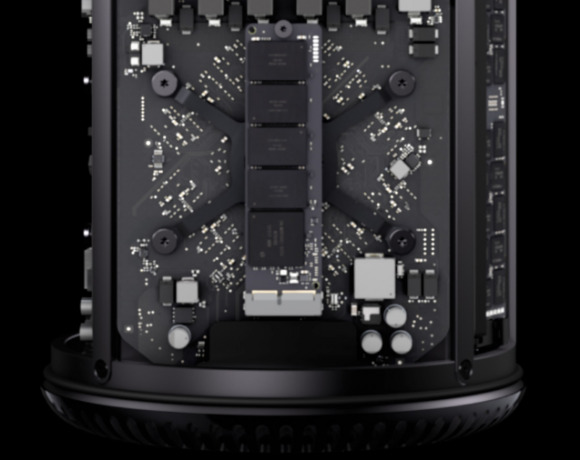
In fact, the new storage technology is up to 2.5x as fast as a SATA SSD, Apple claims. Unlike the flash memory used in, say, the MacBook Air, which is not designed to be user-replaceable, the 2013 Mac Pro looks to be more accessible to the owner, though it's still likely to be a very expensive upgrade. Apple is yet to confirm what storage capacities the new Mac Pro will be offered with, and indeed it's likely to be cheaper to add extra room by plugging in an external drive.
Graphics
Two GPUs are standard on the Mac Pro 2013, recognizing the fact that graphics cards now no longer solely handle display duties, but are also increasingly used for compute purposes. AMD's FirePro workstation range has already been confirmed as supplying the GPU silicon, complete with up to 4096 stream processors, 384-bit memory buses, and 528GBps of total bandwidth.
In fact, Apple says the new Mac Pro delivers up to 7 teraflops of GPU performance, more than double the 2.7 teraflops of the existing machine. The exact AMD GPUs haven't been confirmed, though the specs would suggest custom versions of the FirePro W9000, dubbed by AMD as "the industry's most powerful professional graphics card", at the top end.
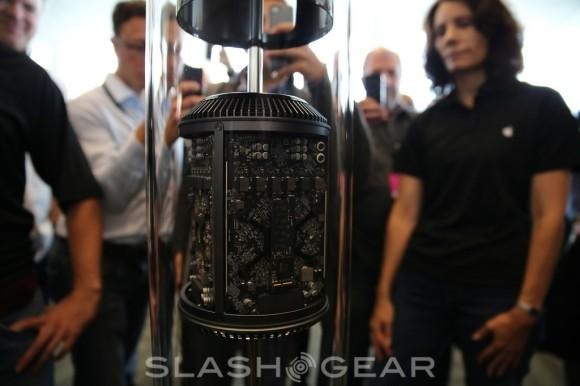
More humble entry-level cards are likely, however, with even the FirePro W500 capable of outputting the full-resolution 4K video Apple promises support for.
In fact, it's looking increasingly likely that Apple will offer an Ultra HD Thunderbolt 2 Display to use alongside the new Mac Pro, given the new focus on 4K resolution. The existing 27-inch Thunderbolt Display runs at 2560 x 1440, significantly less than the 4096 x 2160 that the FirePro cards can support. The new Mac Pro will be able to drive up to three 4K displays simultaneously.
Expansion and I/O
The Mac Pro 2013's power isn't in question; what is already dividing workstation fans is the desktop's potential for expansion. By prioritizing a small footprint and compact storage, there's no internal space for extra hard-drives or other components. Instead, external peripherals are the only way to go.
Apple has already led the way with the adoption of Thunderbolt, and now the Mac Pro will offer Thunderbolt 2. That supports up to 20GB/s data rates and is capable of driving 4K displays; it's also backward compatible with Thunderbolt and, like its predecessor, can be used to daisy-chain up to six devices per port.
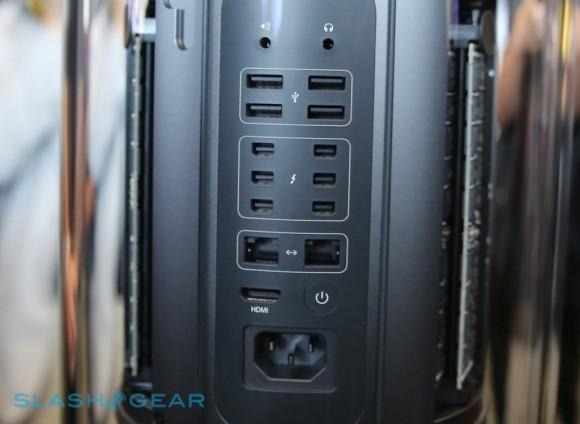
With six on the back of the new Mac Pro, then, there's room for a total of 36 external ultra-high-speed devices; in fact, you still might struggle to find sufficient range of different gadgets to plug in, since Thunderbolt adoption has lagged behind, say, USB 3.0. Thankfully the new Mac Pro also has four USB 3.0 ports.
A microphone input and headphone output, along with two gigabit ethernet ports and an HDMI 1.4 port round out the physical connectivity. The power supply is also internal, so there'll be no bulky block between the Pro and the mains, unlike some small-form-factor PCs. As for wireless connectivity, the Mac Pro 2013 gets the latest WiFi, in the shape of three-stream 802.11ac. There's also Bluetooth 4.0, which will be used for hooking up wireless peripherals like keyboard, trackpad, and mouse, among other things.
Unlike the current Mac Pro, none of the new model's ports are mounted on the front; if you want to plug anything in, you'll have to rotate the desktop around. Still, Apple has made that a little more interesting too, by surrounding the key port sections with illuminated rings that help identify which is which, as well as the power button. It's worth noting that the cut-out for the I/O section on the outer metal sleeve will require you to unplug all the cables in order to remove it.
Pricing and Availability
Apple has described the new Mac Pro glimpse as a preview, and as such there's no official price or release date. However, given the nature of the components Apple is fitting, and the power-user positioning of the Pro itself, this isn't going to be a cheap workstation.
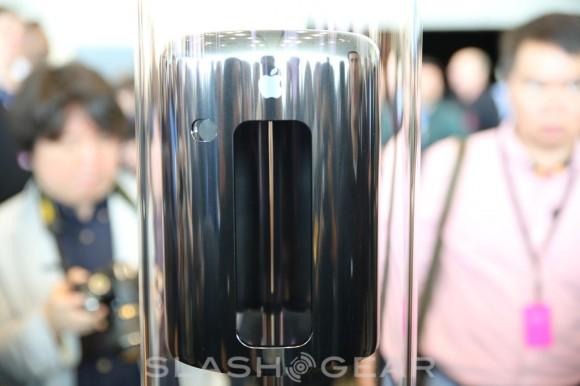
A pair of "entry-level" FirePro W5000 cards have a street price of around $800; step up to a pair of off-the-shelf W9000 cards, meanwhile, and you're looking at more like $6,600. That's before you factor in a chunk of high-speed flash storage, a 12-core Xeon processor, and everything else. Even with Apple's economy of scale, the Mac Pro 2013 is unlikely to undercut the $2,499 starting price of the existing model when it arrives later in 2013.
There's more on the Mac Pro 2013 in our eyes-on report from WWDC.
